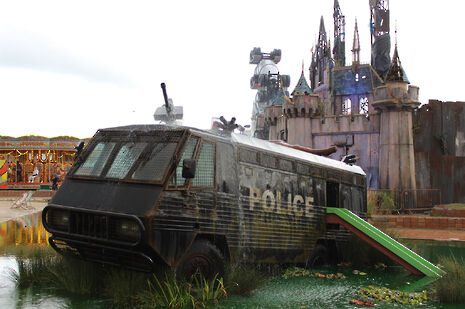Banksy’s jumbled disappointment
As the summer hype surrounding Banksy’s Dismaland dies down, Louis Shankar asks if the post-apocalyptic fariground actually has anything to say

Dismaland, Banksy's art installation-cum-satirical fairground, markets itself as a 'bemusement' park; when leaving the site, my overriding feeling was precisely that - bemusement - so in that respect I guess he succeeded. What I couldn't work out, though, was whether Dimaland was, in its entirety, incredibly clever or deeply flawed, artistic genius or dated, overly-hyped nonsense.
Situated on the Weston-super-Mare seafront, which itself felt like a surrealist installation, Dismaland is far from subtle; how it was kept a secret until launch, I have no idea. “It’s with great pleasure,” the brochure reads, “we throw open the doors of the Tropicana once again.” The hype is inescapable: a permanent queue stretches from the gates with its own dedicated lollypop person; a noticeably young and artsy crowd radiates throughout the town, sticking out like a sore, hipster thumb.
Upon entering, it felt strange. There were a surprising number of pushchairs and toddlers; I’d expected a different crowd for a Wednesday afternoon in September. The food stalls were of a high quality, producing festival-style food throughout the day, including falafel and wood-fired pizza. People seemed more concerned with photographing everything than actually looking at it: I saw an elderly couple take a selfie on an iPhone 6 and a pair of students discuss the respective lengths of their Snapchat stories.
I don’t mean to be too disparaging about the park, it certainly has its highlights and merits. The art exhibition - billed as “the finest collection of contemporary art ever assembled in a North Somerset seaside town” - has some real gems, providing accessible contemporary art for a diverse audience. Disguised attributions had most people looking at and considering everything, rather than just jumping from Banksy to Banksy. The finale of the exhibition - Jimmy Cauty’s model village - was astonishing: a little dystopian police state secreted away in a corner with enough detail to occupy you for hours. Other artworks were spread around the site, from one tent of guerrilla art to another of ‘gothic sculpture’, including a stereotypical Damien Hirst and some sculptures that resembled Bake Off showstoppers gone horribly wrong. A truck-mounted cinema played a series of short films, some of which were genius (opusBou’s The Employment and Ze Frank’s Teddy Has An Operation come to mind), while others were simply strange or boring.
There were many humorous stalls, including David Shrigley's wonderful game of 'knock the anvil over with a ping pong ball', staffed by the most unhelpful employees I've ever met. They were arguably the stars of the show: cynical, delightfully annoying, exactly the opposite of what you’d want from a fairground worker. Whoever they were - drama students presumably - it looked like a thoroughly enjoyable gig.
A major problem I found was how hollow and superficial much of it felt. A piece by Banksy about the migrant crisis was devoid of any real meaning, transformed into a mere attraction. Perhaps this was the point, yet it felt that an artist with such a high profile and such a prominent platform could contribute something worthwhile to the discourse surrounding this humanitarian tragedy.
Perhaps my largest concern with Dismaland, though, was its complicity in the very culture it aimed to criticise. The whitewashed ‘selfie booth’ was being used for genuine, non-ironic selfies, no doubt uploaded online; the centrepiece of a Cinderella/Diana mashup bombarded by paparazzi was itself relentlessly photographed by cameras with too much flash. The whole thing would’ve been much more enlightening if it had been prophetic - set up in the early noughties, perhaps - rather than nostalgic, taking in its sights a culture so inescapable that its message felt moot. As a result, I left feeling altogether disappointed, confused even, until I flicked through the brochure I’d purchased upon exiting. “This is an attempt to build a different kind of family day out - one that sends a more appropriate message to the next generation - sorry kids,” Banksy writes. The message is jumbled, nearly lost entirely amidst the chaos of the park, but maybe this is half the point. To me, this was the genius of Dismaland: it drew you in to its perverse logic, you could barely escape. It was fun but never too fun, satirical yet lacking a degree of depth; only once you took a step back from it all did start to make sense: a passing monument to the confusion, nostalgia and hypnotism that pervades modern life. Here, however, there was an exit - albeit through the gift shop.
 News / Copycat don caught again19 April 2024
News / Copycat don caught again19 April 2024 News / Emmanuel College cuts ties with ‘race-realist’ fellow19 April 2024
News / Emmanuel College cuts ties with ‘race-realist’ fellow19 April 2024 Theatre / The closest Cambridge comes to a Drama degree 19 April 2024
Theatre / The closest Cambridge comes to a Drama degree 19 April 2024 News / Acting vice-chancellor paid £234,000 for nine month stint19 April 2024
News / Acting vice-chancellor paid £234,000 for nine month stint19 April 2024 Interviews / ‘People just walk away’: the sense of exclusion felt by foundation year students19 April 2024
Interviews / ‘People just walk away’: the sense of exclusion felt by foundation year students19 April 2024




